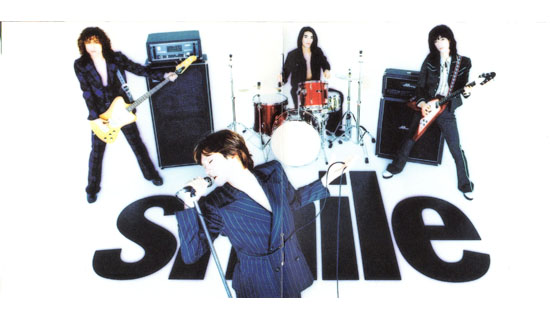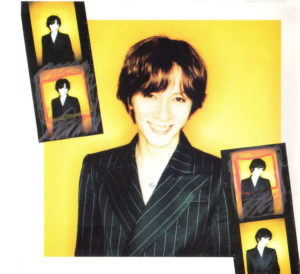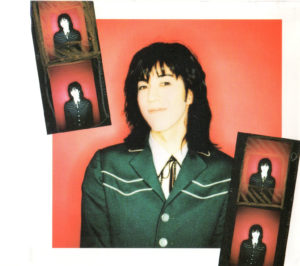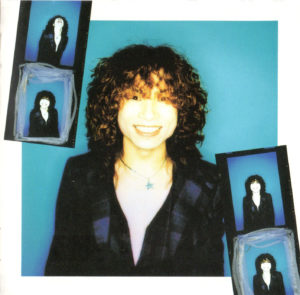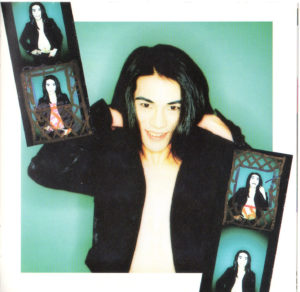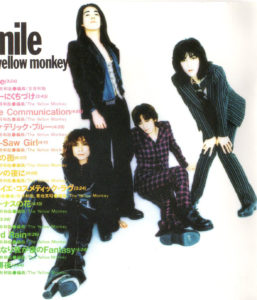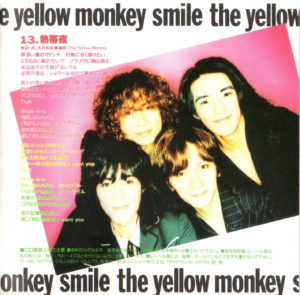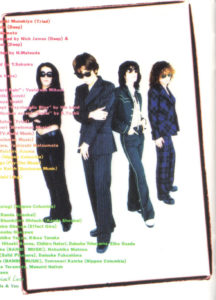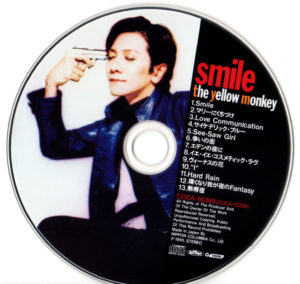
- Smile
- Mary ni Kuchizuke
- Love Communication
- Psychedelic Love
- See-Saw Girl
- Arasoi no Machi
- Eden no Yoru ni
- Yeah Yeah Cosmetic Love
- Venus no Hana
- “I”
- Hard Rain
- Nageku Nari Waga Yoru no Fantasy
- Nettaiya
- Yoake no Scat (B-Side on Nageku Nari Waga Yoru no Fantasy)
How do you follow up an album that had so much heart and soul poured into it as Jaguar Hard Pain? It was a concept album, and it’s definitely not sustainable or advisable to keep making those forever. And the thing about Jaguar, for as good of a critical reception as it received, is that it still didn’t sell as well as the band or their record company wanted it to: The highest it ever got on Japan’s Oricon charts was number 28. They had yet to move into that highly coveted top 10 position. As a still relatively young band on the Japanese rock scene, they and their management obviously both really wanted this. So they were forced to reexamine the choices they were making in regards to song writing.
The booklet that came with the Triad Complete Box collection mentioned that after the release of Jaguar, the band and staff were increasingly troubled as to why nothing was selling as well as they expected. During a meeting, their then director/producer Hiroyuki Munekiyo asked them if they wanted to sell 100,000 copies of something, or get number 1 on the Oricon charts. The band answered that they wanted that place on the charts, so they changed their writing approach to lean more toward songs that could accomplish that. A few months later, their 4th single Nettaiya would be the first song released under that approach. It also didn’t perform as well as they were expecting, given that it even was featured as the ending theme to a popular TV program.
But the point is that they’d changed their approach: They were placing more value on writing music that would sell. Of course they never said this outright in interviews leading up to the album’s release, but they made no efforts to hide that Smile was going to be much more straightforward album than anything that had come before it:
In terms of sound, we’ve been pop this entire time, haven’t we? So one way of looking at it is that if the third album was us performing something abnormal, the fourth album is going to go back to our focus (Laughs) Because I’ve always thought of us as a band who broke through with pop songs, and wants to make that type of music.
Up until Jaguar we may have been making too many adjustments. But after Jaguar was done, there was this whole new part of us. And so then our outlook turned more toward being one of loosening up and just playing more naturally to let that personality come out.
The last album was a concept album, and I think there were parts where personality came out. But because it was a concept album, doesn’t mean it equates to being full of personality. I think this album emphasizes that personality much more strongly.
Everything said up until now has been fairly indirect. You could say that the lyrics are much more straight forward this time around compared to when Lovin wrote the lyrics on Jaguar, or when he’s tried to sing from a woman’s perspective. I think he expresses himself in a much more true way this time around.
Somewhere along the way they also began thinking that Jaguar didn’t meet expectations because it was just too dense and hard to unpack for your average person (which I don’t agree with, but whatever). If that’s how they felt, this change of course was a very natural one to take. And ultimately the album did reach number 4 on the Oricon charts, achieving what they’d set out for:
As an album it feels very much like I’m going full throttle, but there’s a strong feeling of me forcing myself to do it in there too. “smile” reached number 4 on the Oricon charts, but of course I wanted it to be number 1. So that feeling of “We finally did it!” still wasn’t there for me yet: It would only come for the first time later on, with the release of “SICKS”.
So even though Smile was much more successful than anything that had come before it, it still didn’t bring the band the true feeling of success they’d been yearning for. Long time friend of the band and former music publication editor Masami Yuuki also agreed with this assessment in an interview much later on:
To be honest, because I’d known them for a long time and liked much of what they did, so I knew that “smile” wasn’t going to cut it. I just remember thinking that it was extremely catchy, and being shocked by hearing lyrics like “bonjour Japon” (lyrics from Mary ni Kuchizuke) since Yoshii absolutely hadn’t sung anything like that up until that point. I realized that they were putting it all on the line.
Yoshii’s own feelings about writing lyrics at the time may also have something to do with everyone feeling this way:
Actually, when it came to song writing, I was really in a big slump during “smile” (our fourth album). “Love Communication” was me heatedly saying “You want pop songs?! I can make as many of them as you want, whenever you want!” in a very frantic way.
Even so, things were looking more up for Yemon than ever. Not only had they cracked the Oricon top 10, but they’d also booked their first concert at the Nippon Budokan right around the release of Smile, and it completely sold out the day it was announced. But even successes like these lead to Yoshii questioning how something like this could happen and their albums still weren’t selling to match:
Our concert at the Budokan was already booked around the time we put out “smile”, and it completely sold out the same day it was announced. But the weird thing was, we didn’t have the record sales to match. And that was the most frustrating thing of all for me. I was at the point where I was asking “Why are there captive audiences at our concerts, but not for the albums!?”.
But that concert was a very important achievement for Yoshii in even less obvious ways: It led him to change his strange presence from the more gimmicky version of himself that he presented in the early days, to the on-stage Yoshii that we all know now:
I feel like I can pick up on the crowd’s mood very well when it comes to MCs I’m giving while on stage. When the crowd was against me, I tried pulling out my drag queen personality. But then I found myself unable to talk like that anymore. During “Jaguar” all I did was say lines to the crowd in-character, which was interesting in its own way. For our first concert at the Budokan during “smile”, I don’t think I gave any gimmicky MCs like that. I think I just talked to the crowd with a lot of enthusiasm.
And most likely related to that, it was at this time that he stopped drinking to get himself through concerts to combat stage freight:
From the “smile” tour onward, I stopped drinking alcohol before concerts altogether. My father loved One Cup Ozeki sake, and when I go to visit his grave every month I always bring one along. I would drink two of those though, and so I was drunk during a lot of our older shows. I say that I had a lot of vigor during the Jaguar Hard Pain tour, but the truth is I was just drunk. I was completely drunk before the first song started, and it would last until about the middle of our set. Mixing engineers would tell me that my voice was already going, so if I wanted to get signed I should stop drinking before singing. And it ended up being pretty hard to quit!As for why I was drinking in the first place, it’s because I was scared when we performed live. Really scared.
So Smile was a success by any definition, but it still left the band feeling unfulfilled. Though it’s obviously not what they were thinking at the time, I think it’s because this actually wasn’t the sound that they wanted to end up with: It was them over-correcting from Jaguar. Time will end up proving that to be right once we get to subsequent albums, but I don’t doubt that in the moment they thought this was the right thing to do. Rockin’ On Japan called Smile “industrial waste” in reviews at the time. And while I think that’s a bit too harsh, I agree with the core of that opinion.
The biggest mistake that Smile makes isn’t that it’s a pop album. Like Yoshii said earlier, they were always a band with heavy pop influences. It’s that the arrangements are often too simple to the point of being uninteresting, and the lyrics just don’t have Yoshii’s trademark touches on them at all in some cases. This absolutely doesn’t apply to the entire album, as it has some great and very defining songs on it. It starts and ends very strong, with a largely big and saggy middle.
Smile has always been my least favorite of Yemon’s discography, and going into this I was wondering if that was going to change with so many years having passed since the last time I really sat down and listened to it. It hasn’t changed (at least as of now, since I’m doing these in chronological order and haven’t yet moved on to the albums after this one), but I can much more clearly see how this was a necessary step to achieving what would ultimately be their huge success and a much more fluid and balanced sound. Smile represents the growing pains of them getting away from their early career to their later career, and that’s okay. It’s a natural progression that all bands go through, it’s just that much more pronounced with Yemon since we have the benefit of knowing the truly great things that have come before and will come after.
The design of the booklet for Smile is very different from Jaguar Hard Pain‘s, but it’s still extremely good. Hideaki Onishi (aka Jimmy Onishi) is back as the art director and designer, with Tohru Terada doing the cover illustration (though again the concept came from Yoshii). But t bulk of what makes Smile’s booklet design so good is the excellent photography by Mitch Ikeda, the same photographer that did the booklet photos for Jaguar Hard Pain. To match the name of the album, almost all of the photos feature the band with huge grins on their faces. You’ve been seeing them throughout this write-up.
In terms of support musicians, there’s only one familiar name to be found this time around: Takashi Furukawa. He’s been credited with much of the keyboard and synthesizer work that we’ve seen on their major label albums, and here he’s also credited with “Keyboards” in general. However Smile is where we’re introduced to one new and very important person as a support musician for the band: Yoshitaka Mikuni. On this album he’s credited with piano on Psychedelic Blue and Hard Rain, but from the next album up through their breakup in 2001 he’d be their regular keyboardist. Not only that, but starting with Smile he’d also perform live with them as well. Up until now the band had never had a support keyboardist on stage with them during tours.
I’m not sure exactly how the band knew Mikuni, but I strongly suspect it was from some connection through their days playing at La.mama. Mikuni was a guest and/or touring keyboardist for a few different rock and heavy metal acts in the late 80s and early 90s: Anthem, Red Warriors, Diamond Yukai, Ziggy, and Takuji Oyama. He’s even released a few solo albums over the years, and has done some arrangements for anime music in the 90s (Mojakou, Kingyo Chuuihou, and Devil Hunter Yohko). I believe his work is absolutely the main reason that Yemon will start leaning even more toward heavy keyboard parts in their music.
Smile is both hopeful and sad: It marks the end of the sound that so prominently ran through albums like Experience Movie and Jaguar Hard Pain (though the special thanks in the lyrics booklet do explicitly thank “Jaguar” and “Mary”…just after “La.mama” and before “Mick Ronson”), but the very beginning of what will end up as the ultimate expression of Yemon as a band. And while the loss of their old sound is a sacrifice worth making for what they’d become, listening to the transition between those two that is Smile may sometimes be a bit difficult. But I think that depends on just how much value you place in Yoshii’s lyrics being “weird”, and how much tolerance you have for songs that maybe don’t have the most interesting arrangements. Even with that caveat there are some real gems to be had though, particularly in the singles.
